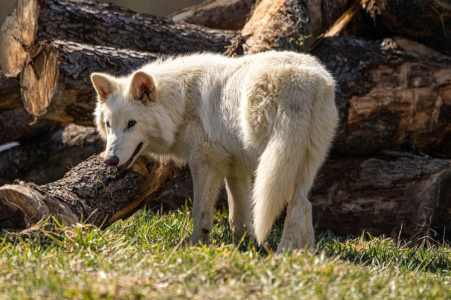Bringing Legendary Creatures Back to Life: Scientists Resurrect Dire Wolves After 12,500 Years
By
- Replies 16
In a feat that seems to have leaped straight out of the pages of a science fiction novel, scientists have achieved a monumental breakthrough in the field of de-extinction. For the first time in 12,500 years, the earth is once again home to Dire Wolves, a species that roamed the planet during the last Ice Age and has since captured the imagination of many, not least due to their depiction in the popular TV series Game of Thrones.
The resurrection of these prehistoric canines is the work of Colossal Biosciences, an American biotech company that has positioned itself at the forefront of de-extinction technology. The company has successfully produced three Dire Wolf pups, affectionately named Romulus, Remus, and Khaleesi, using the DNA extracted from the tooth and skull of the long-extinct animal.
The process involved making 20 unique edits to the animal's DNA, 15 of which were from ancient genes that have not been part of any living creature for over 12 millennia. This groundbreaking work has not only brought back a species from the annals of history but has also demonstrated the incredible potential of genetic engineering.
Ben Lamm, the chief executive of Colossal, expressed immense pride in his team's achievement, stating, 'This massive milestone is the first of many coming examples demonstrating that our end-to-end de-extinction technology stack works.' He went on to describe the process as akin to unveiling 'some of the magic' that the team has been working on, with far-reaching implications for conservation efforts.
The Dire Wolves are currently residing on a sprawling preserve of over 2,000 acres, where they receive round-the-clock care from dedicated staff. This care is not only for their physical well-being but also for their mental health, ensuring that these ancient creatures can thrive in a modern environment.
In addition to the Dire Wolves, Colossal Biosciences has also successfully birthed two litters of red wolves, which are currently the most critically endangered wolf species in the world. By employing a novel approach to non-invasive blood cloning, the company has managed to produce these litters from three genetic founder lines, showcasing the versatility and potential of their de-extinction technologies.
Dr George Church, a co-founder of Colossal and a renowned Harvard geneticist, emphasized the importance of preserving and expanding genetic diversity, particularly for endangered species like the red wolf. He highlighted the company's new technologies, including deep ancient DNA sequencing and multiplex germline editing, as key tools in this endeavor. The Dire Wolf project, he noted, is an early example of these technologies in action, boasting the most significant number of precise genomic edits in a healthy vertebrate to date.
The scientific community and the public alike are intrigued by the implications of such advancements. Dire Wolves, known scientifically as Aenocyon dirus, were once native to the US continent and lived through the Pleistocene ice ages. The oldest known fossil of the animal dates back 250,000 years, with genomic data suggesting their lineage first appeared between 3.5 million and 2.5 million years ago. Their extinction during the most recent ice age left a gap in the ecosystem that has now, astonishingly, been filled.
As we marvel at the return of these majestic creatures, questions arise about the ethical and ecological ramifications of de-extinction. What does it mean for current ecosystems? How will these ancient species adapt to a world vastly different from the one they knew? And what are the broader conservation implications of such technology?
Credit: YouTube

At the Seniors Discount Club, we're always fascinated by the intersection of history, science, and the natural world. We invite you to share your thoughts on this extraordinary scientific achievement. Do you think de-extinction could be a key to preserving our planet's biodiversity, or does it raise concerns that we should be wary of? Let's discuss in the comments below!
The resurrection of these prehistoric canines is the work of Colossal Biosciences, an American biotech company that has positioned itself at the forefront of de-extinction technology. The company has successfully produced three Dire Wolf pups, affectionately named Romulus, Remus, and Khaleesi, using the DNA extracted from the tooth and skull of the long-extinct animal.
The process involved making 20 unique edits to the animal's DNA, 15 of which were from ancient genes that have not been part of any living creature for over 12 millennia. This groundbreaking work has not only brought back a species from the annals of history but has also demonstrated the incredible potential of genetic engineering.
Ben Lamm, the chief executive of Colossal, expressed immense pride in his team's achievement, stating, 'This massive milestone is the first of many coming examples demonstrating that our end-to-end de-extinction technology stack works.' He went on to describe the process as akin to unveiling 'some of the magic' that the team has been working on, with far-reaching implications for conservation efforts.
The Dire Wolves are currently residing on a sprawling preserve of over 2,000 acres, where they receive round-the-clock care from dedicated staff. This care is not only for their physical well-being but also for their mental health, ensuring that these ancient creatures can thrive in a modern environment.
In addition to the Dire Wolves, Colossal Biosciences has also successfully birthed two litters of red wolves, which are currently the most critically endangered wolf species in the world. By employing a novel approach to non-invasive blood cloning, the company has managed to produce these litters from three genetic founder lines, showcasing the versatility and potential of their de-extinction technologies.
Dr George Church, a co-founder of Colossal and a renowned Harvard geneticist, emphasized the importance of preserving and expanding genetic diversity, particularly for endangered species like the red wolf. He highlighted the company's new technologies, including deep ancient DNA sequencing and multiplex germline editing, as key tools in this endeavor. The Dire Wolf project, he noted, is an early example of these technologies in action, boasting the most significant number of precise genomic edits in a healthy vertebrate to date.
The scientific community and the public alike are intrigued by the implications of such advancements. Dire Wolves, known scientifically as Aenocyon dirus, were once native to the US continent and lived through the Pleistocene ice ages. The oldest known fossil of the animal dates back 250,000 years, with genomic data suggesting their lineage first appeared between 3.5 million and 2.5 million years ago. Their extinction during the most recent ice age left a gap in the ecosystem that has now, astonishingly, been filled.
As we marvel at the return of these majestic creatures, questions arise about the ethical and ecological ramifications of de-extinction. What does it mean for current ecosystems? How will these ancient species adapt to a world vastly different from the one they knew? And what are the broader conservation implications of such technology?
Credit: YouTube
Key Takeaways
- Colossal Biosciences has successfully birthed three Dire Wolves, an extinct species, using ancient DNA from fossils.
- The groundbreaking achievement involved making 20 unique edits to the animal's DNA, with 15 edits from genes over 12,000 years old.
- The Dire Wolves, named Romulus, Remus, and Khaleesi, are being cared for on a large preserve, highlighting the project's conservation efforts.
- The company also announced the birth of two litters of red wolves, a critically endangered species, using advanced cloning techniques.
Last edited by a moderator:








